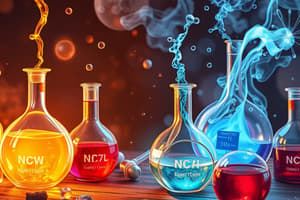Podcast
Questions and Answers
What is the primary difference between a mixture and a solution?
What is the primary difference between a mixture and a solution?
- The chemical properties of the substances
- The physical state of the substances
- The uniform distribution of the substances (correct)
- The number of substances involved
Which of the following is an example of an element?
Which of the following is an example of an element?
- Saltwater
- Sugar water
- Carbon dioxide
- Hydrogen (correct)
What is the purpose of a chemical equation?
What is the purpose of a chemical equation?
- To determine the atomic number of an element
- To classify the type of chemical reaction
- To describe the physical properties of a substance
- To represent the chemical reaction using symbols and formulas (correct)
What is the term for the number of protons in an atom's nucleus?
What is the term for the number of protons in an atom's nucleus?
What is the result of a chemical reaction?
What is the result of a chemical reaction?
What is the term for a substance formed by the chemical combination of two or more different elements?
What is the term for a substance formed by the chemical combination of two or more different elements?
What is the common characteristic of all the things that occupy space and have mass?
What is the common characteristic of all the things that occupy space and have mass?
What is the concept that was debated by two schools of thought regarding the nature of matter?
What is the concept that was debated by two schools of thought regarding the nature of matter?
What is the basis of the classification of matter according to modern day scientists?
What is the basis of the classification of matter according to modern day scientists?
What is the term used to describe the five basic elements classified by ancient Indian philosophers?
What is the term used to describe the five basic elements classified by ancient Indian philosophers?
What aspect of matter will be taken up in subsequent chapters?
What aspect of matter will be taken up in subsequent chapters?
What is the primary reason for the initially observed lack of change in the water level when salt or sugar is dissolved in it?
What is the primary reason for the initially observed lack of change in the water level when salt or sugar is dissolved in it?
What can be inferred from the fact that the solution of potassium permanganate remains coloured even after repeated dilution?
What can be inferred from the fact that the solution of potassium permanganate remains coloured even after repeated dilution?
What do the observations from Activity 1.4 suggest about the nature of particles in a liquid?
What do the observations from Activity 1.4 suggest about the nature of particles in a liquid?
What can be inferred from the observation that the smell of the incense stick is detected even at a distance after it is lit?
What can be inferred from the observation that the smell of the incense stick is detected even at a distance after it is lit?
What is the primary reason for the difference in the rate of dissolution of copper sulphate or potassium permanganate in hot and cold water?
What is the primary reason for the difference in the rate of dissolution of copper sulphate or potassium permanganate in hot and cold water?
Study Notes
Mixtures and Solutions
- Mixture: A physical blend of two or more substances, where each substance maintains its chemical properties.
- Examples: sand and water, salt and pepper
- Solution: A homogeneous mixture of two or more substances, where one substance (solute) is dissolved in another substance (solvent).
- Examples: saltwater, sugar water
- Suspension: A heterogeneous mixture of two or more substances, where the particles of one substance are suspended in another substance.
- Examples: muddy water, whipped cream
Elements and Compounds
- Element: A substance that consists of only one type of atom, represented by a unique symbol (e.g., H, C, O).
- Examples: hydrogen, carbon, oxygen
- Compound: A substance formed by the chemical combination of two or more different elements, represented by a chemical formula (e.g., H2O, CO2).
- Examples: water, carbon dioxide
- Atomic number: The number of protons in an atom's nucleus, which determines the element.
- Molecular formula: A formula that shows the number and type of atoms in a molecule.
Chemical Changes
- Chemical reaction: A process in which one or more substances are transformed into new substances.
- Examples: combustion, rusting, photosynthesis
- Reactants: The substances that undergo a chemical change.
- Products: The new substances formed as a result of a chemical reaction.
- Chemical equation: A representation of a chemical reaction using symbols and formulas.
Physical Properties
- Physical property: A characteristic of a substance that can be observed or measured without changing its chemical composition.
- Examples: color, texture, melting point, boiling point
- Extensive property: A physical property that depends on the amount of substance, such as mass or volume.
- Intensive property: A physical property that does not depend on the amount of substance, such as density or temperature.
- Phase: A state of matter, such as solid, liquid, or gas, which can be changed by altering the physical conditions (e.g., temperature, pressure).
Studying That Suits You
Use AI to generate personalized quizzes and flashcards to suit your learning preferences.
Description
Test your knowledge of the fundamental concepts in chemistry, including mixtures, solutions, elements, compounds, chemical reactions, and physical properties. Learn to identify and distinguish between different types of mixtures, elements, and compounds, and understand the basics of chemical changes and physical properties.




